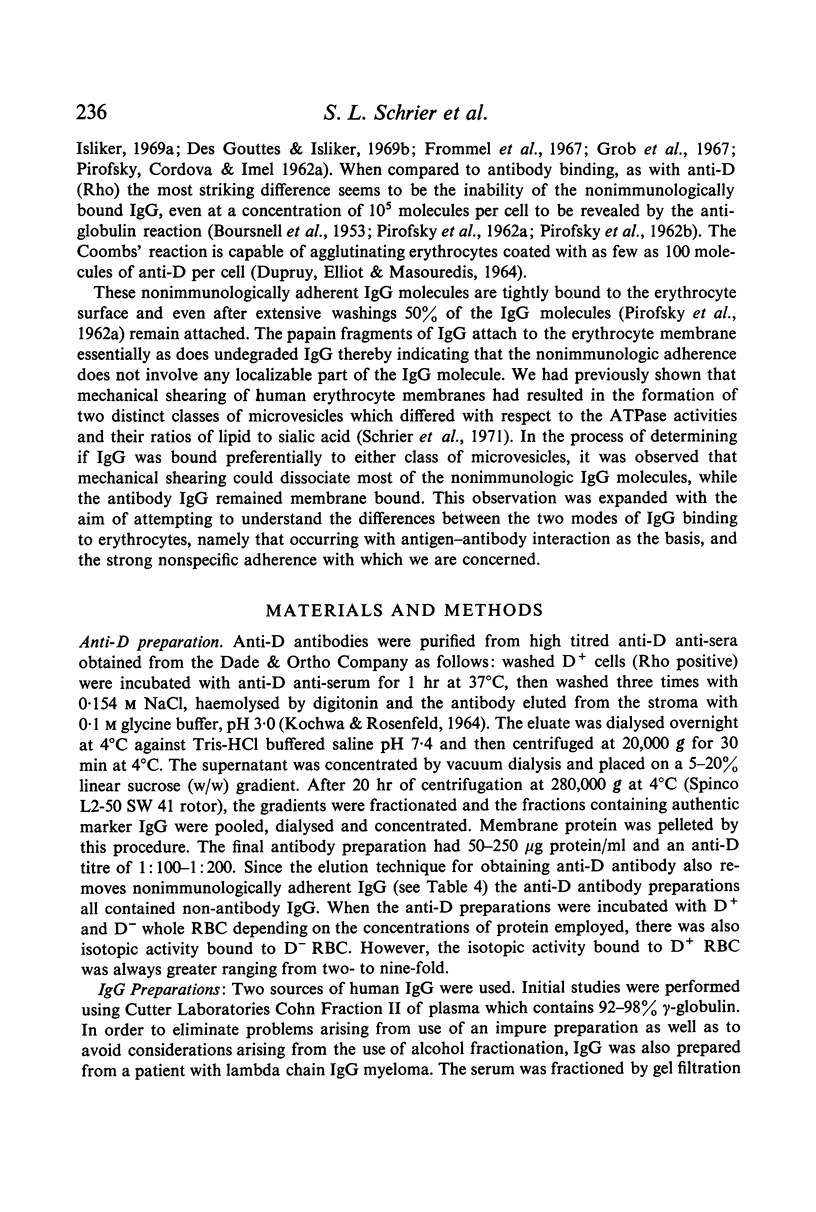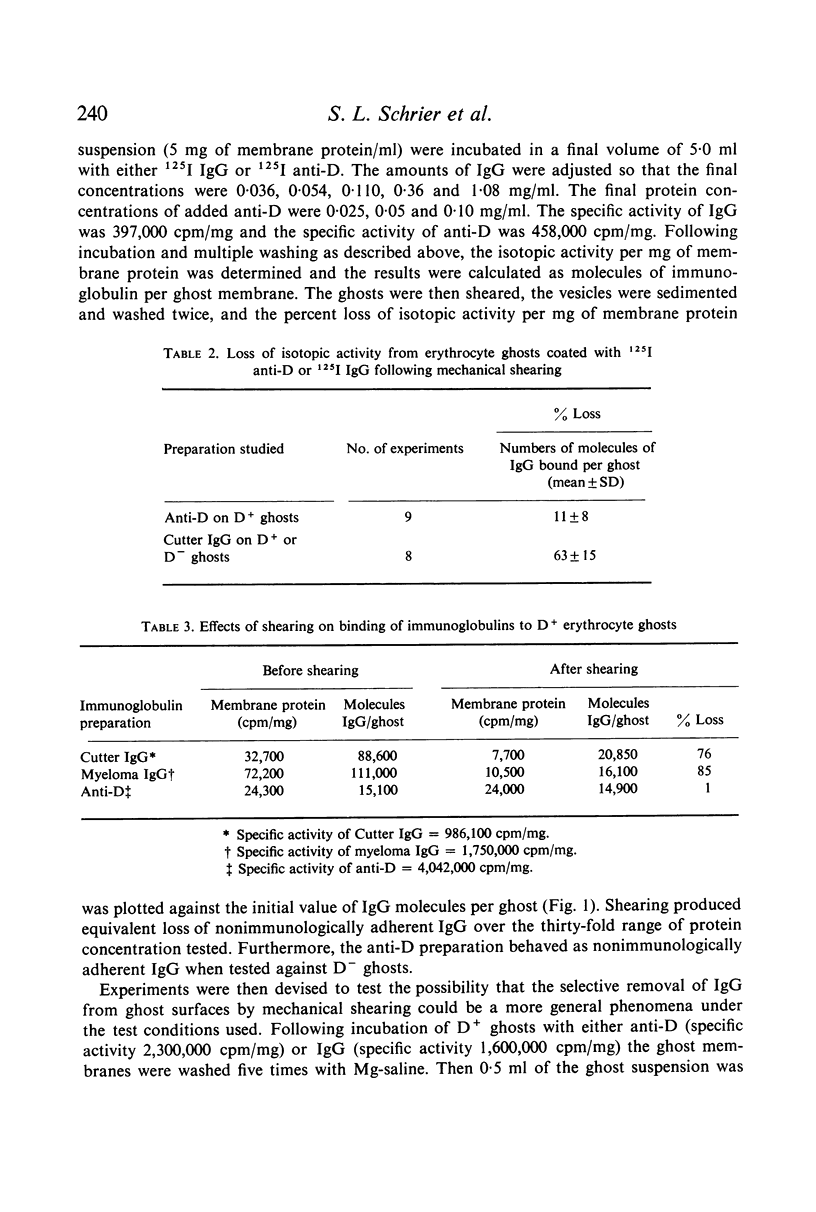Abstract
These studies were undertaken with the aim of detecting possible differences between immunologic binding of IgG antibodies to erythrocyte membranes and the well documented nonimmunologic adherence to erythrocytes of large numbers of IgG molecules. In the experiments described D+(Rho) erythrocyte ghosts were incubated with either 125I labelled anti-D or 125I IgG and then thoroughly washed. The ghosts which contained either immunologically bound anti-D or adherent IgG were then passed through a French press which converted the ghosts into microvesicles composed of membrane material. This procedure resulted in the selective removal of nonimmunologically adherent IgG from the microvesicles while leaving most of the antibody still firmly bound to the microvesicles. A series of control studies revealed that this observation was not limited to a single preparation of anti-D or IgG, and was not related to the number of IgG molecules attached to the erythrocyte membrane. Selective methods of chemical elution did not distinguish between the two forms of IgG attachment nor did another physical manipulation i.e. freezing and thawing. Separation of the sheared microvesicles into distinct classes indicated that antibody binding and nonimmunologic adherence of IgG molecules occurred equally to each of the different vesicle classes. These observations indicated that antibody binding and nonimmunologic adherence of IgG differ with regard to their physical characteristics and this difference may be a reflection of the inability of nonimmunologically adherent molecules to react with the Coombs' reagent.
Full text
PDF









Selected References
These references are in PubMed. This may not be the complete list of references from this article.
- BOURSNELL J. C., COOMBS R. R., RIZK V. Studies with marked antisera; quantitative studies with antisera marked with iodine 131isotope and their corresponding red-cell antigens. Biochem J. 1953 Dec;55(5):745–758. doi: 10.1042/bj0550745. [DOI] [PMC free article] [PubMed] [Google Scholar]
- DUPUY M. E., ELLIOT M., MASOUREDIS S. P. RELATIONSHIP BETWEEN RED CELL BOUND ANTIBODY AND AGGLUTINATION IN THE ANTIGLOBULIN REACTION. Vox Sang. 1964 Jan-Feb;9:40–44. doi: 10.1111/j.1423-0410.1964.tb03766.x. [DOI] [PubMed] [Google Scholar]
- Des Gouttes D., Isliker H. Etude de la fixation non spécifique des immunoglobulines G sur les érythrocytes. I. Influence de la variation de différents paramètres. Acta Haematol. 1969;42(3):154–168. doi: 10.1159/000208775. [DOI] [PubMed] [Google Scholar]
- Des Gouttes D., Isliker H. Etude de la fixation non spécifique des immunolobulines G sur les érythrocytes. II. Easais d'inhibition par des immunoglobulines G natives ou modifićes et par d'autres protéines. Acta Haematol. 1969;42(4):219–229. doi: 10.1159/000208782. [DOI] [PubMed] [Google Scholar]
- Edgington T. S. Dissociation of antibody from erythrocyte surfaces by chaotropic ions. J Immunol. 1971 Mar;106(3):673–680. [PubMed] [Google Scholar]
- Frommel D., Grob P. J., Masouredis S. P., Isliker H. C. Studies on the mechanism of immunoglobulin binding to red cells. Immunology. 1967 Nov;13(5):501–508. [PMC free article] [PubMed] [Google Scholar]
- Green F. A. Phospholipid requirement for Rh antigenic activity. J Biol Chem. 1968 Oct 25;243(20):5519–5521. [PubMed] [Google Scholar]
- Grob P. J., Frommel D., Isliker H. C., Masouredis S. P. Interaction of IgG and its fragments with red cells. Immunology. 1967 Nov;13(5):489–499. [PMC free article] [PubMed] [Google Scholar]
- KOCHWA S., ROSENFIELD R. E. IMMUNOCHEMICAL STUDIES OF THE RH SYSTEM. I. ISOLATION AND CHARACTERIZATION OF ANTIBODIES. J Immunol. 1964 May;92:682–692. [PubMed] [Google Scholar]
- LOWRY O. H., ROSEBROUGH N. J., FARR A. L., RANDALL R. J. Protein measurement with the Folin phenol reagent. J Biol Chem. 1951 Nov;193(1):265–275. [PubMed] [Google Scholar]
- MASOUREDIS S. P. Relationship between RhO(D) genotype and quantity of 1131 anti-RhO(D) bound to red cells. J Clin Invest. 1960 Sep;39:1450–1462. doi: 10.1172/JCI104164. [DOI] [PMC free article] [PubMed] [Google Scholar]
- McConahey P. J., Dixon F. J. A method of trace iodination of proteins for immunologic studies. Int Arch Allergy Appl Immunol. 1966;29(2):185–189. doi: 10.1159/000229699. [DOI] [PubMed] [Google Scholar]
- PIROFSKY B., CORDOVA M. S., IMEL T. L. The mechanism of action of antiglobulin serum. Vox Sang. 1962;7:348–361. doi: 10.1111/j.1423-0410.1962.tb03263.x. [DOI] [PubMed] [Google Scholar]
- PIROFSKY B., CORDOVA M. S., IMEL T. L. The nonimmunologic reaction of globulin molecules with the erythrocyte surface. Vox Sang. 1962;7:334–347. doi: 10.1111/j.1423-0410.1962.tb03262.x. [DOI] [PubMed] [Google Scholar]
- Schrier S. L., Giberman E., Danon D., Katchalski E. Studies on ATPase in sheared micro vesicles of human erythrocyte membranes. Biochim Biophys Acta. 1970;196(2):263–273. doi: 10.1016/0005-2736(70)90014-3. [DOI] [PubMed] [Google Scholar]
- Schrier S. L., Giberman E., Katchalski E. Variability in ouabain-induced inhibition of human erythrocyte membrane (Na+ K+)-ATPase. Biochim Biophys Acta. 1969 Jul 15;183(2):397–400. doi: 10.1016/0005-2736(69)90096-0. [DOI] [PubMed] [Google Scholar]
- Schrier S. L., Godin D., Gould R. G., Swyryd B., Junga I., Seeger M. Characterization of microvesicles produced by shearing of human erythrocyte membranes. Biochim Biophys Acta. 1971 Mar 9;233(1):26–36. doi: 10.1016/0005-2736(71)90354-3. [DOI] [PubMed] [Google Scholar]
- Steck T. L., Straus J. H., Wallach D. F. A model for the behavior of vesicles in density gradients: implications for fractionation. Biochim Biophys Acta. 1970 Jun 2;203(3):385–393. doi: 10.1016/0005-2736(70)90179-3. [DOI] [PubMed] [Google Scholar]


